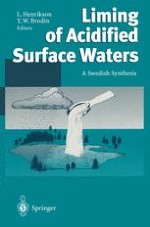1995 | OriginalPaper | Buchkapitel
The impact of liming on aquatic communities
verfasst von : Magnus Appelberg
Erschienen in: Liming of Acidified Surface Waters
Verlag: Springer Berlin Heidelberg
Enthalten in: Professional Book Archive
Aktivieren Sie unsere intelligente Suche, um passende Fachinhalte oder Patente zu finden.
Wählen Sie Textabschnitte aus um mit Künstlicher Intelligenz passenden Patente zu finden. powered by
Markieren Sie Textabschnitte, um KI-gestützt weitere passende Inhalte zu finden. powered by
The far-reaching changes in the number and composition of plant and animal species which normally occur in conjunction with the liming of lakes and watercourses involve major changes in the structure and function of communities of organisms and the complexity of food webs. This is primarily attributable to changes in water chemistry, but interaction within and among species is of crucial importance to the post-liming development of a community. The short-term effects of liming often differ from those of the long-term effects. Normally, individual species expand rapidly for a short time, since competition and predation are reduced and there is a surplus of nutrients. In certain cases, this may have undesirable effects such as blooms of certain phytoplankton species, sharp increases in macrophytes or abnormal expansion of fish populations. The long-term impact, on the other hand, is to a great extent determined by biotic factors such as competition and predation within the new post-liming abiotic limits which emerge.Despite the fact that, in most cases, the flora and fauna in limed lakes and watercourses resemble those which are to be found in unacidified waters, most surveys suggest that communities in limed waters will never fully return to their pre-acidification states. The post-liming production capacity of the water is crucial to both the species composition and the length of the food chain. In general, the complexity of the food web in limed water will be reduced as a result of a continued decline in the supply of inorganic nutrients, which may in turn be attributable to decreased mobility of phosphorus in the soil profile of the acidified catchment area.In severely acidified lakes where fish populations have completely disappeared, the number of trophic levels has been reduced from four to three: primary producers (phytoplankton, macrophytes and epiphytic algae), herbivores, and invertebrate secondary consumers (predators). After liming, the number of trophic levels usually returns to four when fish resume their position as the highest level in the community.The change in the length of the food chain affects the underlying trophic levels from the top downwards, i.e. predation has an impact on lower levels. In the pelagic food chain, the composition of zooplankton is affected in such a way that the smaller forms of plankton tend to dominate, which in turn alters the grazing pressure on the phytoplankton and has a significant impact on the composition of phytoplankton species. Even in the littoral food web, a shift from larger to smaller invertebrates takes place. A “bottom-up” effect has been demonstrated in a number of cases, with changes at lower trophic levels affecting higher levels after liming. The outcome of a liming treatment thus depends largely on wether the predator or the prey is the most affected by the change in water chemistry.A limed freshwater usually constitutes a more variable environmet than an unacidified water, with greater fluctuations in the acidification-dependent variables over a given period of time. This can be expected to result in communities where the average food chain is shorter than in unaffected waters. While local disturbances themselves may affect competition between different species. Species diversity may therefore be greater in limed waters, since less competitive species have a better chance to survive.
